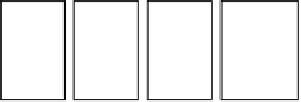Information Technology Reference
In-Depth Information
Inter Frame Space (AIFS) number and re-transmission limit [22]. Depending on
the traffic class assigned, the particular traffic will undergo different packet-
dropping probabilities and delay constraints. Therefore, the proposed transmission
solution with IEEE 802.11e assigns higher priority for important parts of the video
bit-stream whereas less important components are assigned a lower priority traffic
class.
Mapping to Access Category
Legacy:
one priority
Lower priority
Higher priority
TC0
TC1
TC2
TC3
backoff
AIFS
CW
backoff
AIFS(3)
CW(3)
backoff
AIFS(2)
CW(2)
backoff
AIFS(1)
CW(1)
backoff
AIFS(0)
CW(0)
Virtual Collision Handler
Transmission
attempt
Transmission attempt
Fig. 3
Virtual back off of Traffic Categories (TCs) with DCF (left) and EDCA (right)
methods
2.4 Robust Transmission
Generic error resilience techniques and channel protection schemes can make the
video data more resilient to channel degradations. If they are separately optimized,
the performance gain is limited. A significant improvement in performance has
been demonstrated by the use of adaptive optimization of source and channel
codes as in joint source-channel coding approaches [23].
These techniques can be divided into two areas: channel-optimized source
coding and source-optimized channel coding. In the first approach, the channel-
coding scheme is fixed and the source coding is designed to optimize the perform-
ances. In the case of source-optimized channel coding, the optimal channel code is
derived for a fixed source code. The application of source optimized channel cod-
ing for video transmission in error prone propagation environments is considered
in [24, 25]. However, the derivation of optimal channel coding at the physical link
layer for fixed source coding at the application layer requires modification of all














